
The 6th Bomb Group
Honors and Awards
Group Honors
Distinguished Unit Citation (DUC)
|
|
The Army Distinguished Unit Citation (later the Presidential Unit Citation) was awarded for "for extraordinary heroism in action against an armed enemy". |
|---|---|
All members of the unit may wear the decoration, whether or not they personally participated in the acts for which the unit was cited. However, only those assigned to the unit at the time of the action cited may wear the decoration as a permanent award. The ribbon shown above includes an "Oak Leaf Cluster" indicating two awards. The 6th Bomb Group received two Distinguished Unit Citations: |
|
Individual Medals and Awards
Silver Star
 |
The Silver Star is the third highest medal for valor (below the Medal of Honor and the Distinguished Service Cross). The Silver Star is awarded to any person who, while serving in any capacity with the United States Armed Forces, is cited for gallantry in action against an enemy of the United States while engaged in military operations involving conflict with an opposing foreign force. |
|---|---|
|
9 members of the 6th Bomb Group received the Silver Star: Mission #20. Mitsubishi Aircraft Co, Nagoya (Apr 7):
Mission #43. Tokyo Urban Area (May 23):
Mission #44. Tokyo Urban Area (May 25):
Mission #74. Yawata Steel Works (Aug 8):
|
|
Legion of Merit
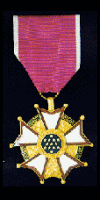 |
The Legion of Merit is awarded to all members of the Armed Forces of the United States without reference to degree for exceptionally meritorious conduct in the performance of outstanding services and achievements. The performance must have been such as to merit recognition of key individuals for service rendered in a clearly exceptional manner. Performance of duties normal to the grade, branch, specialty or assignment, and experience of an individual is not an adequate basis for this award. |
|---|---|
|
One man in the 6th Bomb Group received the Legion of Merit:
|
|
Distinguished Flying Cross (DFC)
 |
The Distinguished Flying Cross is awarded to any person who, while serving in any capacity with the Armed Forces of the United States, distinguishes himself by heroism or extraordinary achievement while participating in aerial flight. The performance of the act of heroism must be evidenced by voluntary action above and beyond the call of duty. The extraordinary achievement must have resulted in an accomplishment so exceptional and outstanding as to clearly set the individual apart from his comrades or from other persons in similar circumstances. Awards will be made only to recognize single acts of heroism or extraordinary achievement and will not be made in recognition of sustained operational activities against an armed enemy. |
|---|---|
|
Over 300 members of the 6th Bomb Group (about 1/3 of the air crews) received the DFC. The following is a partial listing. The DFC Citations are included with the mission to show the circumstances under which the medals were earned. By accident or design, the DFC was generally awarded to crews with around 25 missions. But, as the Citations show, they earned every one of them. Contrary to what Ernie Pyle said, these were not "milk runs". Mission 16. Shimonoseki Straits (Mar 27)
Mission 20. Mitsubishi Aircraft Company (Apr 7)
Mission 25. Kawasaki Urban Area (Apr 15) Mission 28. Kanoya East Airfield, Kyushu (Apr 21)
Mission 29. Kanoya East Airfield, Kyushu (Apr 22)
Mission 30. Hitachi Aircraft Company (Apr 24)
Mission 33. Kanoya East Airfield, Kyushu (Apr 28)
Mission 43. Tokyo Urban Area (May 23-24)
Mission 44. Tokyo Urban Area (May 25-26)
Mission 45. Yokohama Urban Area (May 29)
Mission 46. Osaka Urban Area (June 1) Mission 47. Kobe Urban Area (June 5)
Mission 48. Osaka Urban Area (June 7)
Mission 62. Rashin, Fusan in Korea (July 11)
The most recent member of the 6th Bomb Group to receive this award is Clarence Pressgrove, who received his DFC in 2003. The officer who had originally recommended Pressgrove for the medal in 1945 was killed during a training flight and the award was never made. |
|
Soldiers Medal
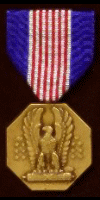
|
The Soldier's Medal is awarded to any person of the Armed Forces of the United States who, while serving in any capacity with the Army of the United States, distinguished himself or herself by heroism not involving actual conflict with an enemy. The same degree of heroism is required as for the award of the Distinguished Flying Cross. The performance must have involved personal hazard or danger and the voluntary risk of life under conditions not involving conflict with an armed enemy. Awards will not be made solely on the basis of having saved a life. For example, someone who rescues trapped crewmembers from a burning or ditched plane might qualify for this award. |
|---|---|
|
At least 31 members of the 6th Bomb Group received the Soldiers Medal. They include:
|
|
Bronze Star

|
The Bronze Star is awarded to any person who, while serving in any capacity in or with the military of the United States distinguishes himself or herself by heroic or meritorious achievement or service, not involving participation in aerial flight, while engaged in an action against an enemy of the United States or while engaged in military operations involving conflict with an opposing foreign force. Many members of the ground crews, particularly the Crew Chiefs, received Bronze Stars as recognition for the long hours they spent keeping the planes in the air. |
|---|---|
|
Some of the recipients were:
|
|
Air Medal
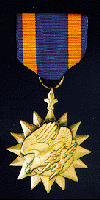
|
The Air Medal is awarded to any person who, while serving in any capacity in or with the armed forces of the United States, shall have distinguished himself by meritorious achievement while participating in aerial flight. Air crews received an Air Medal for first 5 mission; a bronze Oak Leaf Cluster for each additional 5 missions and a silver Oak Leaf Cluster in lieu of five bronze. Most air crew who served with the 6th Bomb Group received an Air Medal (for 5 missions). Those who flew 35 missions also received a silver Oak Leaf Cluster (for the next 25) and a bronze Oak Leaf Cluster (for the last 5 missions). |
|---|---|
Army Commendation Ribbon (now Medal)
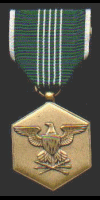
|
In WWII this decoration was originally only a ribbon and was awarded to any member of the Armed Forces of the United States, other than General Officers, who distinguished himself by heroism, meritorious achievement or meritorious service. Awards may be made for acts of valor performed which are of lesser degree than required for award of the Bronze Star Medal. These acts may involve aerial flight. An award may be made for acts of noncombatant-related heroism which do not meet the requirements for an award of the Soldier’s Medal. Bronze "V" device worn to denote Valor/Heroism in Combat. Second and subsequent awards are denoted by bronze Oak Leaf Clusters; a silver Oak Leaf Cluster is worn in lieu of five bronze. |
|---|---|
Purple Heart
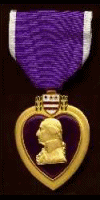
|
This is the one medal that no one wanted to earn. At the beginning of the war, this medal was awarded for valor or for injuries received in combat. Later in the war, the medal was awarded only for injuries (although the word "Valor" still appears on the back of the medal). Those who earned this medal deserve our special respect and thanks. |
|---|---|
At least 34 members of the 6BG received this award. Some shipped home. Others returned to combat. The recipients include:
|
|
Service Medals
Prisoner of War (POW) Medal
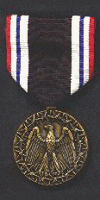
|
The Prisoner of War Medal was not created until 1985. This medal is awarded to U.S. military personnel who were taken prisoner and held captive while engaged in an action against an enemy of the United States or while engaged in military operations involving conflict with an opposing foreign force. Members of the 6th Bomb Group who are entitled to this medal may have to request one. |
|---|---|
|
At least 34 members of the 6th Bomb Group should qualify for this medal, including: Mission 16. Shimonoseki Straits (Mar 27)
Mission 43. Tokyo Urban Area (May 23-24)
Mission 43. Tokyo Urban Area (May 23-24)
Mission 44. Tokyo Urban Area (May 25-26)
Mission 66. Inland Sea Harbors (July 19)
|
|
Good Conduct Medal
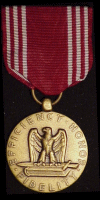 |
The Good Conduct Medal was awarded to enlisted personnel who honorably served one year of federal military service while the United States is at war. Clasps are awarded for second and subsequent awards. Most members of the 6th Bomb Group received this award. |
|---|
Campaign Medals
American Campaign Medal
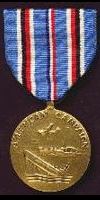 |
The American Campaign Medal was awarded to personnel for service within the American Theater between 7 December 1941 and 2 March 1946. One bronze star is worn on the ribbon to indicate participation in an authorized air combat campaign from 7 Dec 41 - 2 Sep 45. Everyone in the 6th Bomb Group should have received this medal. All air crews should have received a bronze star. |
|---|
Asiatic-Pacific Campaign Medal and Battle Stars
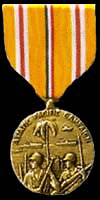 |
The Asiatic-Pacific Campaign Medal was awarded to personnel for service within the Asiatic-Pacific Theater between 7 December 1941 and 2 March 1946. In addition, personnel received Campaign and Battle Stars (attached to the ribbon) for participating in any of 21 defined campaigns. 6th Bomb Group personnel received the following:
Everyone in the 6th Bomb Group should have received this medal. Most should have received 3 Stars. |
|---|
World War II Victory Medal
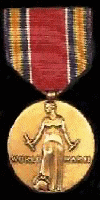 |
The World War II Victory Medal was awarded to any member of the Armed Forces who served at least one day of active federal service between December 7, 1941 and December 31, 1946. Everyone in the 6th Bomb Group should have received one of these Medals. |
|---|
Rotation Points
|
Most important of all, crews received points based on missions flown and time in service. Those who had enough points got to go home. Those who did not remained a "guest" of the military for as long as a full year. |
|---|
Honorable Discharge Medal
 |
The Honorable Discharge Medal (the "Ruptured Duck") was awarded to all personnel honorably discharged from the military. It is not worn on the uniform. |
|---|
Wearing the Ribbons
 A Sample "Ribbon Rack" that includes (in order): Distinguished Flying Cross Soldiers Medal, Air Medal, Purple Heart Good Conduct, American & Asiatic-Pacific Campaigns, WWII Victory |
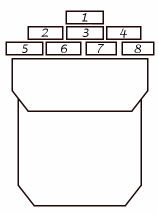 |
|---|---|
|
According to official instructions: |
|
|
When pinning on your ribbons, start with the lowest ranking one just above the left breast pocket of your blouse or shirt, at the side nearer your left arm. As you go up the ladder of decorations add them to the right of what is already pinned, to make a row of either three or four. 1/8" above the first line apply the next in the same manner. The last row on top, however, is always centered. An easy rule to remember is: The higher the value of the ribbon, the higher it is placed. Ribbon number 1 in the illustration is for the decoration ranking highest in the order of precedence which follows. a. Medal of honor |
|
|
The instructions do not mention the Distinguished Unit Citation (DUC) or the Prisoner of War (POW) Medal:
|
|